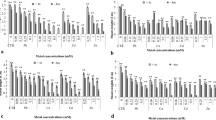Abstract
In laboratory experiments, the rhizobacteria Azospirillum lipoferum 137, Arthrobacter mysorens7, Agrobacterium radiobacter 10, and Flavobacterium sp. L30 were found to have a relatively high resistance to the toxic heavy metals lead and cadmium (except that strain L30 was found to be sensitive to Cd). When introduced by means of seed bacterization, the heavy metal–resistant strains actively colonized the rhizosphere of barley plants cultivated in uncontaminated and contaminated soils. In both pot and field experiments, seed bacterization improved the growth of barley plants and the uptake of nutrient elements from soil contaminated with Pb and Cd. The bacterization also prevented the accumulation of Pb and Cd in barley plants, thereby mitigating the toxic effect of these heavy metals on the plants.
Similar content being viewed by others
REFERENCES
Skerfving, S., Bencko, V., Vahter, M., Schutz, A., and Gerhardsson, L., Environmental Health in the Baltic Region: Toxic Metals, Scand. J. Work Environ. Health, 1999, vol. 25, pp. 40–64.
Sanita di Toppi, L. and Gabrielli, R., Response to Cadmium in Higher Plants, Environ. Exp. Bot., 1999, vol. 41, pp. 105–130.
McGrath, S.P., Effects of Heavy Metals from Sewage Sludge on Soil Microbes in Agricultural Ecosystems, Toxic Metals in Soil-Plant Systems, Ross, S.M., Ed., Wiley & Sons, 1994, pp. 247–273.
Gadd, G.M., Heavy Metal Accumulation by Bacteria and Other Microorganisms, Experientia, 1990, vol. 46, pp. 834–840.
Kuster, E. and Grun, I., Cadmium and Soil Microorganisms, Angew. Bot., 1984, vol. 58, pp. 31–38.
Garmash, N.U., Bulavko, G.I., Naplekova, N.N., and Garmash, G.A., The Role of Microorganisms and Plants in Lead Detoxification, Agrokhimicheskie issledovaniya v Sibiri (Agrochemical Studies in Siberia), Krasnoyarsk: Sib. Otd. Lesa Drev., 1984, pp. 126–130.
Belimov, A.A., Safronova, V.I., Sergeyeva, T.A., Egorova, T.N., Matveyeva, V.A., Tsyganov, V.E., Borisov, A.Y., Tikhonovich, I.A., Kluge, C., Preisfeld, A., Dietz, K.-J., and Stepanok, V.V., Characterization of Plant Growth-promoting Rhizobacteria Isolated from Polluted Soils and Containing 1-Aminocyclopropane-1-Carboxylate Deaminase, Can. J. Microbiol., 2001, vol. 47, pp. 642–652.
Burd, G.I., Dixon, D.G., and Glick, B.R., Plant Growth-promoting Bacteria That Decrease Heavy Metal Toxicity in Plants, Can. J. Microbiol., 2000, vol. 46, pp. 247–245.
Belimov, A.A. and Dietz, K.-J., Effect of Associative Bacteria on Element Composition of Barley Seedlings Grown in Solution Culture at Toxic Cadmium Concentrations, Microbiol. Res., 2000, vol. 155(II), pp. 113–121.
Belimov, A.A., Kunakova, A.M., Gruzdeva, E.V., Vasilyeva, N.D., Vorobyev, N.I., Kojemyakov, A.P., Khamova, O.F., Postavskaya, S.M., and Sokova, S.M., Relationship between Survival Rates of Associative Nitrogen Fixers on Roots and Yield Response of Plants to Inoculation, FEMS Microbiol. Ecol., 1995, vol. 17, pp. 187–196.
Khotyanovich, A.V., Metody kul'tivirovaniya azotfiksiruyushchikh bakterii, sposoby polucheniya i primeneniya preparatov na ikh osnove (The Cultivation of Nitrogen-fixing Bacteria, Their Biopreparations, and Application in Agriculture), Leningrad: Vseross. Inst. Rast., 1991, p. 60.
Babich, H. and Stotsky, G., Sensitivity of Various Bacteria, Including Actinomycetes and Fungi, to Cadmium and the Influence of pH on the Sensitivity, Appl. Environ. Microbiol., 1977, vol. 55, pp. 681–695.
Duxbury, T. and Bicknell, B., Metal Tolerant Bacterial Populations from Natural and Metal-polluted Soils, Soil Biol. Biochem., 1983, vol. 15, pp. 243–250.
Belimov, A.A., Ivanchikov, A.Yu., and Vorob'ev, N.I., The Effect of Predominant Microflora of the Barley Rhizoplane on the Interaction between Introduced Diazotrophs and the Plant, Mikrobiologiya, 1998, vol. 67,no. 3, pp. 424–430.
Belimov, A.A., Kojemiakov, A.P., and Chuvarliyeva, G.V., Interaction between Barley and Mixed Cultures of Nitrogen-fixing and Phosphate-Solubilizing Bacteria, Plant Soil, 1995, vol. 173, pp. 29–37.
Bashan, Y., Harrison, S.K., and Whitmoyer, R.E., Enhanced Growth of Wheat and Soybean Plants Inoculated with Azospirillum brasilense Is Not Necessarily Due to General Enhancement of Mineral Uptake, Appl. Environ. Microbiol., 1990, vol. 56, pp. 769–775.
Pacovsky, R.S., Fuller, G., and Paul, E.A., Influence of Soil on the Interactions between Endomycorrhizae and Azospirillum in Sorghum, Soil Biol. Biochem., 1985, vol. 17, pp. 525–531.
Verkleij, J.A.C. and Schat, H., Mechanisms of Metal Tolerance in Higher Plants, Heavy Metal Tolerance in Plants: Evolutionary Aspects, Boca Raton: CRC, 1990, pp. 179–193.
Author information
Authors and Affiliations
Rights and permissions
About this article
Cite this article
Belimov, A.A., Kunakova, A.M., Safronova, V.I. et al. Employment of Rhizobacteria for the Inoculation of Barley Plants Cultivated in Soil Contaminated with Lead and Cadmium. Microbiology 73, 99–106 (2004). https://doi.org/10.1023/B:MICI.0000016377.62060.d3
Issue Date:
DOI: https://doi.org/10.1023/B:MICI.0000016377.62060.d3



